More than the Portishead blues – shore delights at Portishead
More than the Portishead blues – shore delights at Portishead
Written by Dr Rhoda Ballinger, SEP Chair
I discover more hidden treasures along our Severn shores and sample sections of the coast from Redcliffe Bay (Somerset) to Portishead Marina. Offering a brief insight into the maritime and natural history of this coast, I recount my observations from my very chilly visit early in the New Year.
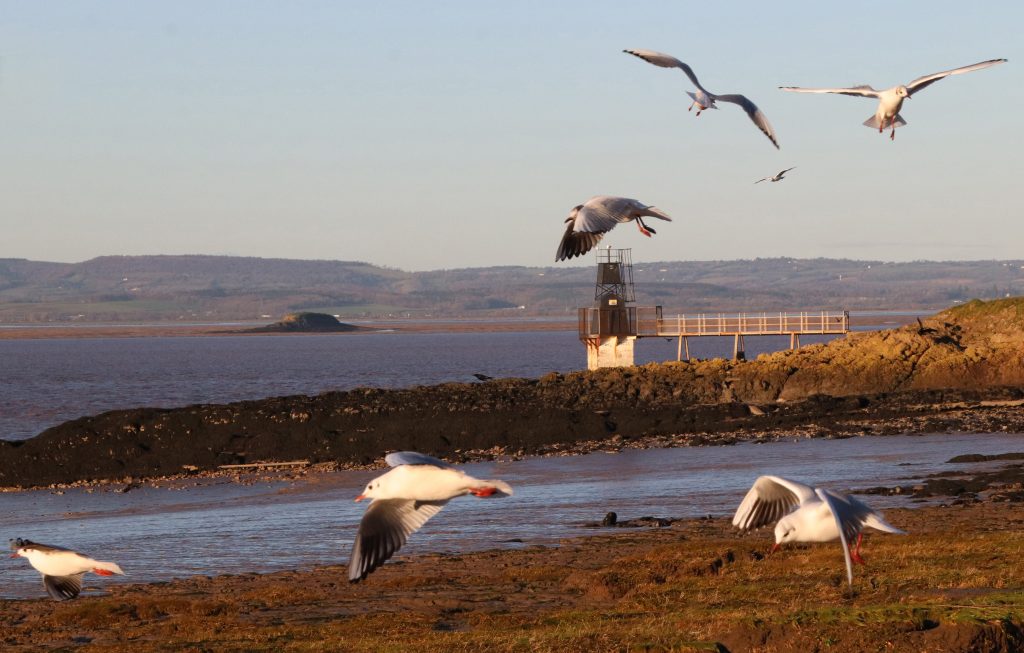
Black-headed gulls with their winter plumage circling in front of Battery Point Lighthouse
Introduction
On one of the coldest but clearest of days early in January, I ventured out with Geoff, my husband, to the explore the coast from Redcliffe Bay (Somerset) to Portishead Marina, taking in sections of the North Somerset Tidal Trail and the Gordano Round. Ever since sailing around the Upper Estuary on the Waverley last summer, I’d been intrigued to explore this stretch of coast further – I’d not only been surprised by the grandeur of the former National Nautical School from offshore but also the unexpected swathes of natural shoreline so close to the docks downstream of the Avon. Given the extreme temperatures and the limited hours of daylight, it was more of a Saga tour than an exhilarating walk, hopping in and out of our car to sample the highlights and then try to get warm. We even took the advice from the online Bristol Barkers’ walk and tested the delights of the Windmill Inn for lunch – to be recommended!
Supplementing my impressions from our brief visit, I’m delighted to share with you more informed views from a couple of Portishead town councillors. Councillor Jenie Eastman (councillor for West Ward including Redcliffe Bay) has lived in Portishead for nearly 30 years, and like me, is a proud geographer with a passion for exploring the balance between the physical and human worlds. Councillor David Gunnell (councillor for North Ward including the Lake Grounds area) is an even longer-term resident of Portishead, who, as a retired clinician and academic, is passionate about mental wellbeing as well as being a volunteer on a local nature reserve.
Safety first: Lighthouses along the Portishead shore
One of the main attractions of the Portishead shore is the view across the estuary towards Denny Island/Ynys Denny, just three miles offshore. On such a calm day this tiny uninhabited island appeared little more than a dark hump emerging out of the still estuary waters at high tide, but as the tides receded further the full extent of the offshore sandbanks and muddy shores were revealed – this reminded us of more serious, safety matters and the need for navigational aids along this potentially treacherous stretch of coast. Brunel’s great transatlantic passenger ship, the SS Great Western ran aground off Nore Point in 1838 and this was the impetus for the construction of Black Nore Lighthouse in 1894. Inspired by this, we made our way along the muddy but still slightly frosty path to the lighthouse. Gleaming in the winter sunshine and casting long dark shadows across the beach below, it was easy to see why this slightly quirky Grade II listed ‘pepper pot’ lighthouse is such an inspiration for local artists. Its white cast iron tower sits atop a skirt of six metallic legs, looking more like a Wallace and Gromit model spaceship ora ‘stilted steam-punk iron torch,’ as Matt Gilbert describes it in his poem ‘At Black Nore Lighthouse,’ than a serious piece of engineering. On such a calm day, however, this solitary sentinel exuded a calm authority and sense of comfort – after all, it had watched over this stretch of waters for well over a hundred years, until its decommissioning in 2010.
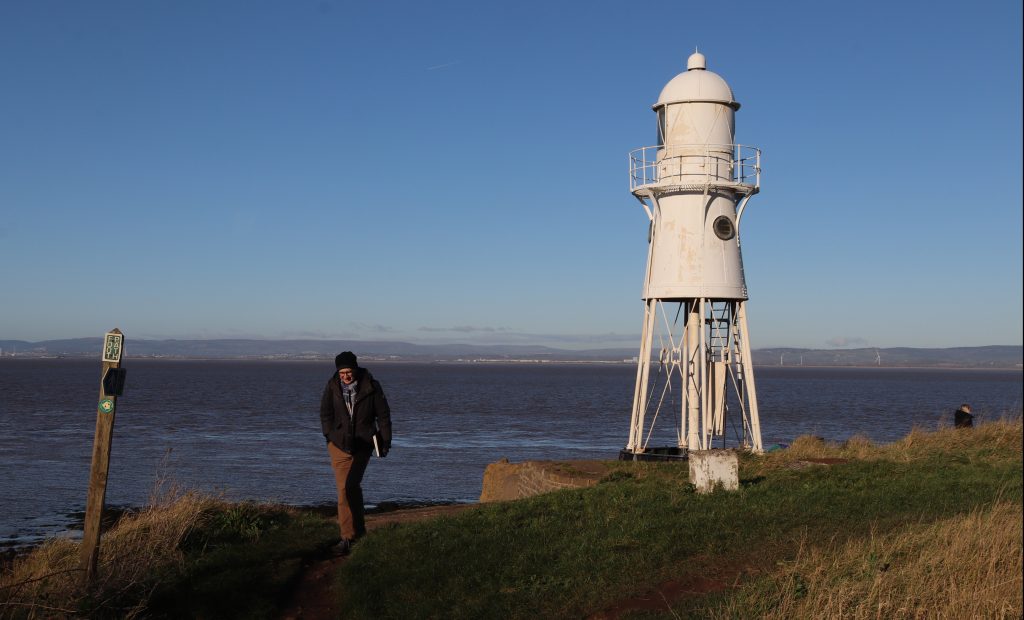
Geoff walking along the coastal path at Black Nore Lighthouse
Not surprisingly given the coast’s proximity to the entrance of Royal Portbury Dock, there’s another lighthouse just upstream on the tip of Portishead Point, as mariners refer to it, or Battery Point, if you’re a local. Continuing our lighthouse crawl, we approached this 9-metre-high structure from the coast path and were immediately aware of its somewhat more unusual design than its cousin down the coast – with its black metal pyramid tower resting on a rather grey and weathered square concrete base, it looked more like a miner’s lamp than a navigational aid. Lying silent and still, it was also difficult to imagine this relatively small structure providing sufficient warning for shipping. This automatic navigational light, however, is still fully functional, being maintained by the Bristol Port Company and remains critical to navigation. Just as well, given that large ships pass closer to land here than anywhere else along the entire UK coastline! A local campaign has also ensured that the lighthouse’s original two-tonne fog bell, which was removed due to structural issues, is not forgotten. It’s now been re-erected near the town’s centre as a reminder of Portishead’s maritime past.
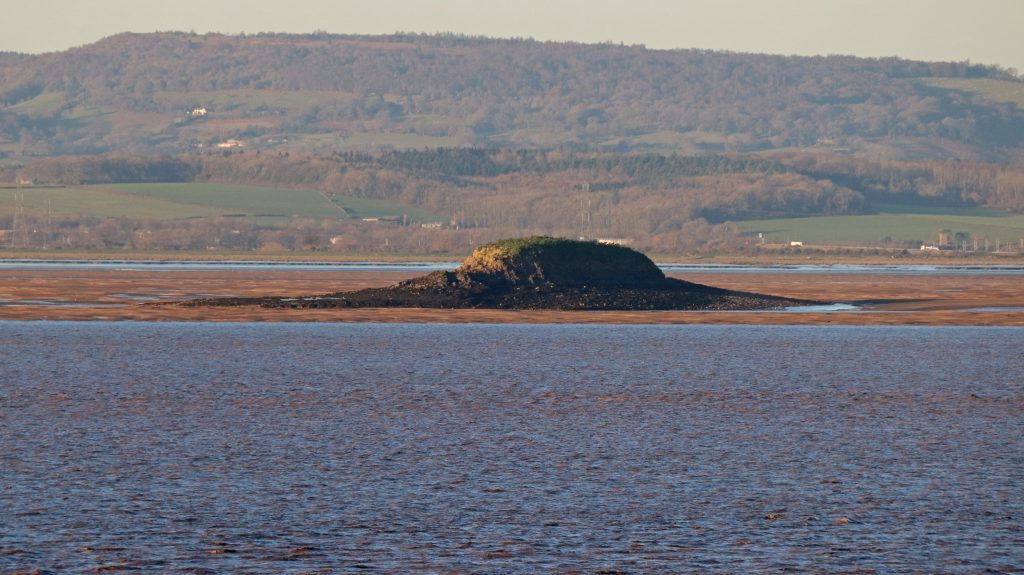
A distant view of Denny Island, Wales – an inspiration for Melania Trumps’ milliner?!
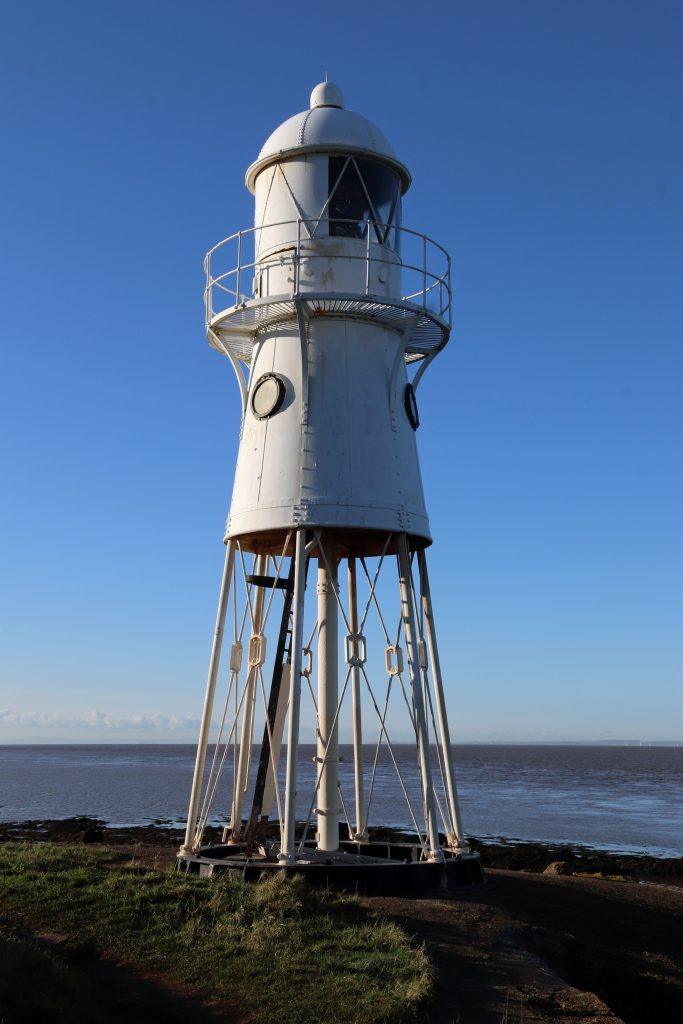
A close-up of Black Nore Lighthouse
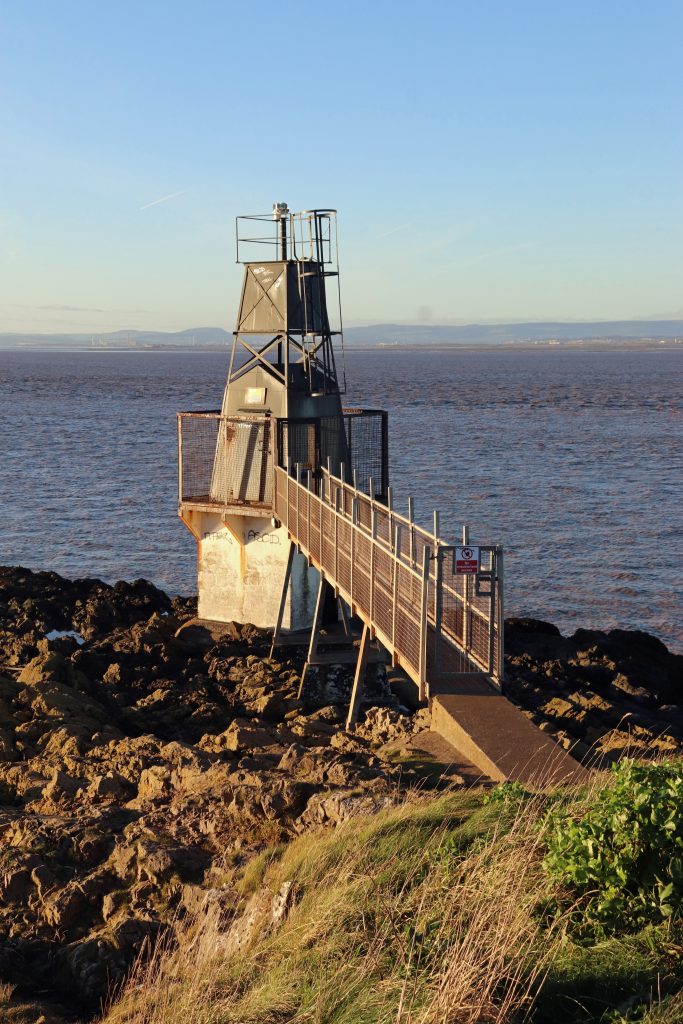
Battery Point Lighthouse
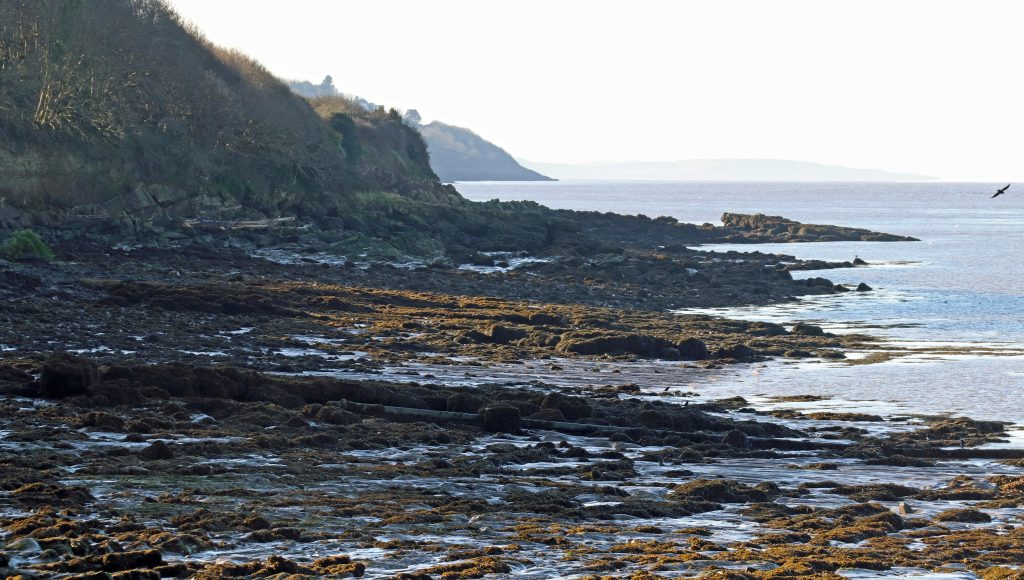
Looking along the rocky shore towards Redcliffe Bay
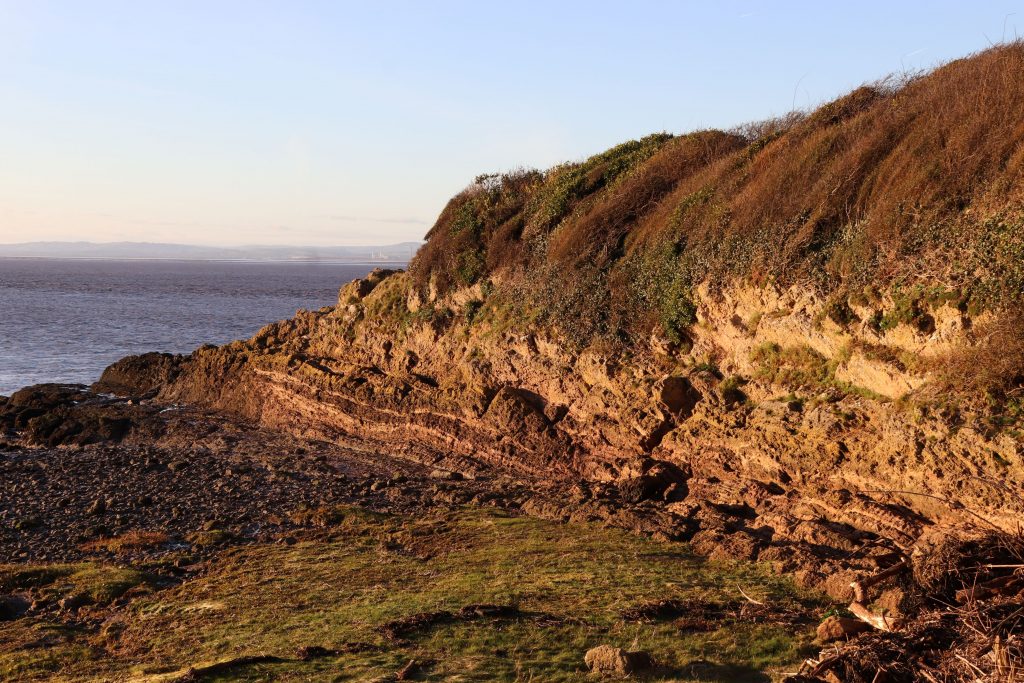
Impressive geological strata near Portishead/Battery Point, glowing in the low winter sun
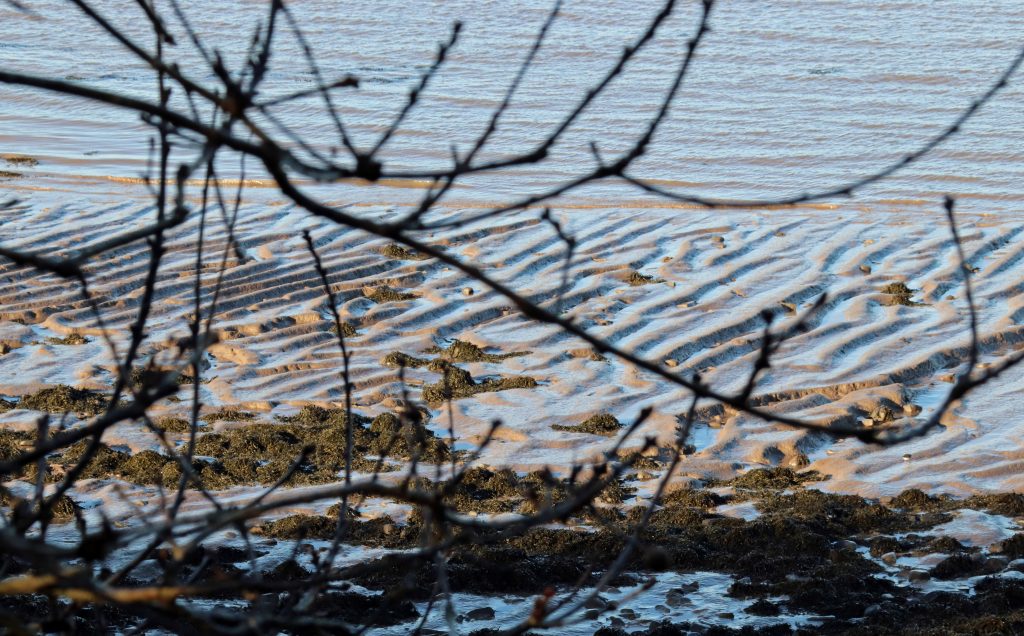
Supersized ripples along the muddy shores
Natural shore delights
Whilst the lighthouses are interesting, it is the natural beauty of the coast which is the main attraction to many locals, particularly given its proximity to people’s homes. Councillor Gunnell was keen to point out that ‘In Portishead, we are extremely fortunate to live close to such a lovely stretch of coastline, rich in wildlife, geology and fantastic views.’ Councillor Eastman also expressed her love of the ‘the wide variety of landscapes, beaches and rock formations’ here.
Our trundle along the coast path south of the Battery Lighthouse towards Redcliffe Bay enabled us to sample some of these delights, although in such cold, slippery conditions we couldn’t clamber across the shore to really appreciate the varied geology, hidden coves and rock pools teeming with life for which this coast is so prized. Occasional glimpses of the geology revealed amazing rock structures, dating back to a major mountain-building period in geological history, the Variscan period, some 350 million years ago, when the supercontinent of Pangea was formed. However, the red rocks of Redcliffe Bay eluded us as we peered through the wooded cliff line into the sun. We’ll have to come another day to explore these ancient rocks and to search for fossil fish scales in Woodhill Bay.
We were, however, treated to some spectacular coastal vistas. Not only were there extensive panoramas across to south Wales, but, in the low winter sunshine on a falling tide, I was mesmerized by the intricate patterns formed as deep dark, gullies and giant ripples emerged along the muddy shores. Etched into the shimmering mud these ephemeral features were a reminder of the immense power of the tidal and fluvial currents along this coast. More accessible but equally attractive were our driftwood finds close to Black Nore Lighthouse. These mighty chunks of wood, strewn haphazardly across the backshore, looked particularly beautiful with a light sprinkling of frost. Councillor Eastman clearly spends much of her spare time hunting for such natural treasures along the beach here and at Sugar Loaf Bay ‘The Glass Beach’ where locals scour the shore for polished glass. Indeed, she was proud to inform me that her bathroom boasts ‘a huge fabric banner painted with shells, pebbles, bird’s eggs etc, hanging from a huge piece of driftwood scavenged from the beach in front of the house’ in her bathroom. I guess I’m not the only person who goes home with pockets full of beach treasures! Perhaps you’ve some artwork from the Severn shores you’d like to share with us? – we’d love to hear from you if you have!
Having started our day parked in the cul-de-sac of a somewhat featureless 1960/70s housing estate, we were slightly surprised and relieved to discover that the coastal path going south to Redcliffe Bay takes you beside natural green shores and through extensive woodlands. Thankfully, the thin veneer of deciduous woodland which hugs the shore has been preserved and at least gave us an illusion of a country walk. The dark winter skeletons of the trees, bereft of their summer foliage, also provided ample opportunities for photos, handsomely framing the expansive views of estuary behind. We marvelled at the variety of trees and shrubs, the contorted shapes of trees sculptured by the prevailing westerlies, and the giant fungi wrapping around many an ancient tree trunk – no wonder Councillor Eastman was so enthusiastic for these natural spaces, praising them for their ‘amazing birds, wildflowers, blackberries, elderberries and hawthorn.’ Clearly, from the number of dog walkers, runners and cyclists on our brief visit, this is a popular stretch of coast.
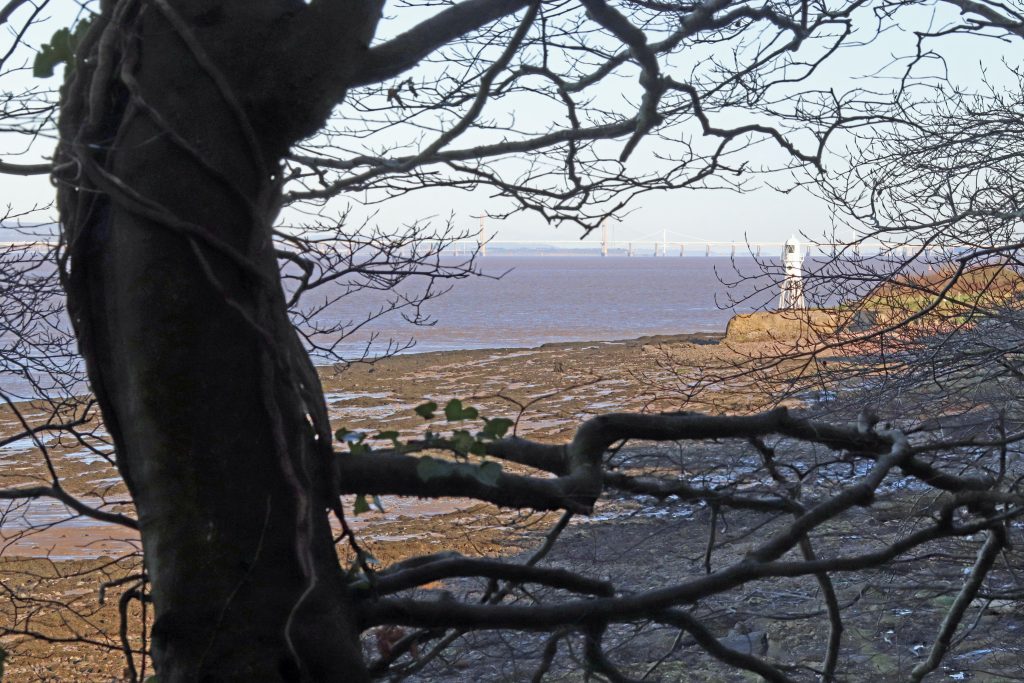
Woodland framing a view along the shore towards the Prince of Wales Bridge
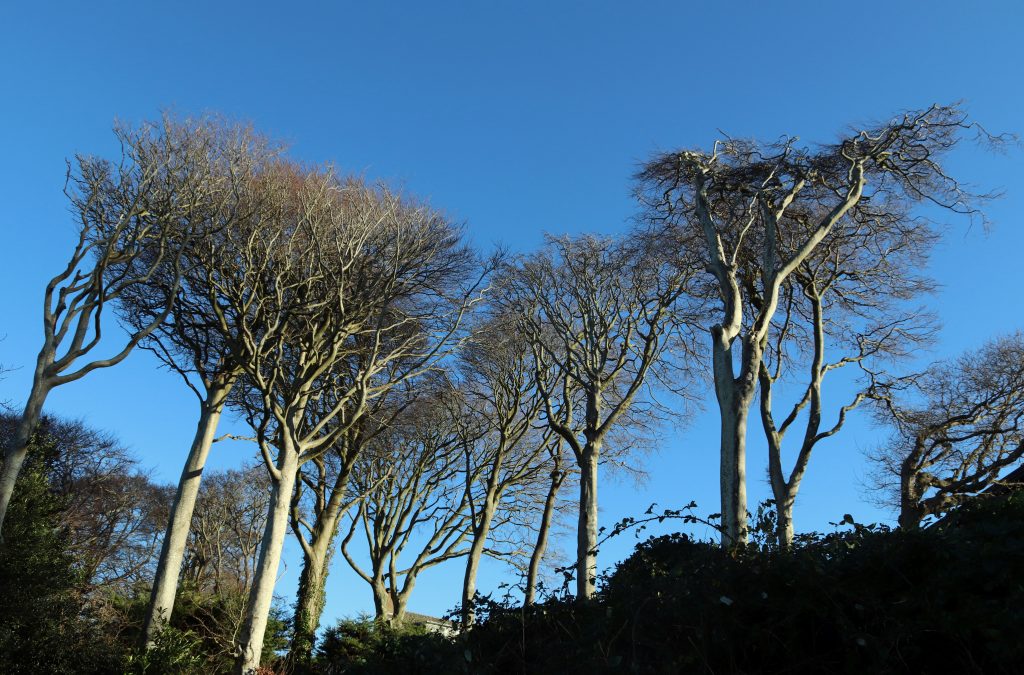
Trees sculptured by the offshore westerlies
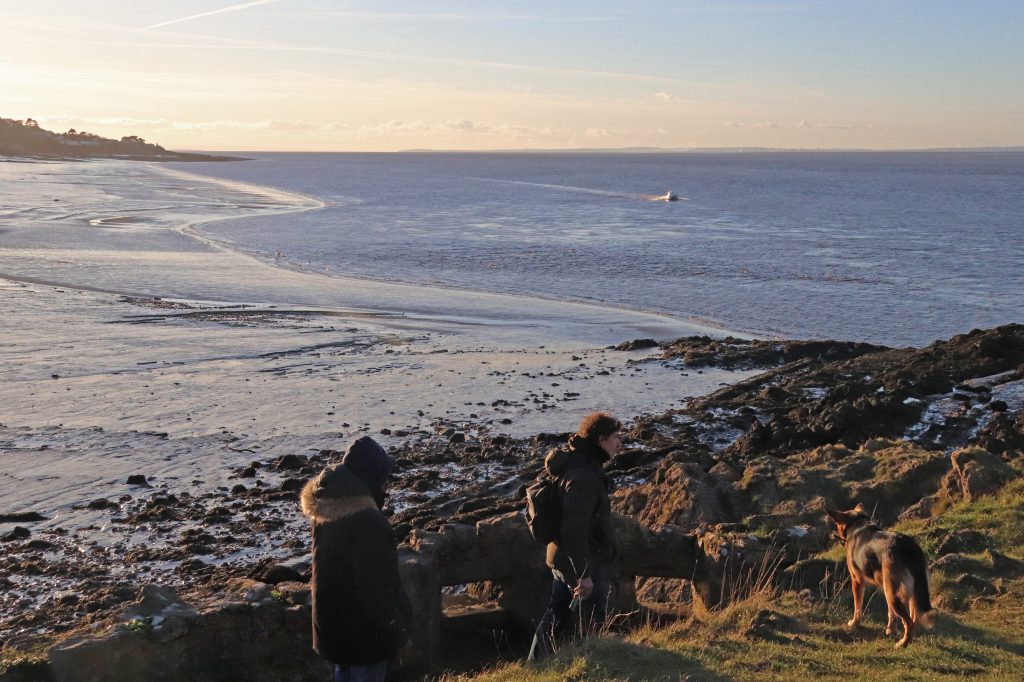
Dog walkers along Woodhill Bay
Portishead: seaside suburbia
Our lunch in the Windmill Inn enabled us to appreciate coastal views up towards the Prince of Wales Bridge in the warmth. We were reminded though, that wherever you are along this stretch of coast, you’re never far away from suburbia. The rapid urbanisation which beset our estuary’s towns and cities in the 60s and 70s is very much in evidence here – indeed the statistics for Portishead show a near three- times population expansion since the early 1960s. Councillor Eastman points out though that ‘not that much has really changed that much in the last 50 years.’ However, what would have been 60s/70s suburban uniformity, with ever-changing fashions and home-owner aspirations, now is a living museum demonstrating exterior household renovation and a triumph of individualisation. With the insatiable appetite for sea views, the pressure for further residential infilling continues. Nestling behind an old sea wall close to Black Nore lighthouse, we glimpsed the elegant façade of the National Nautical School modelled on the Royal Naval College at Dartmouth. This impressive building has now been repurposed and transformed into Fedden Village, offering desirable apartments with enviable Channel views and secluded coastal grounds.
Portishead is certainly much more than the ‘Bristol outrider and a suburb by the sea with a muddy beach’ as Peter Finch describes it. After lunch we ventured down to Councillor Gunnell’s ‘much loved Portishead Lake Grounds Park,’ the English sister of Cold Knap Lake at Barry on the estuary’s Welsh shore. As we circuited the sports fields and the marine lake admiring the ducks and swans, it was hard to imagine how this area had been transformed from the ‘thorny brushwood and stagnant rhines’ of Rodmoor into this very popular recreational area for residents and visitors. Even more challenging was the thought of the efforts of those employed in its construction – seemingly, it had been a job creation scheme back in 1910 for the Bristol unemployed and was to provide some sort of compensation for Portishead’s lack of a sandy beach. As we had walked around and tried to avoid the slightly flooded, squishy grassy areas, it was no surprise later to find that both Councillors Gunnell and Eastman expressed considerable concern about potential flood risk from sea level rise here. Councillor Gunnell suggested ‘another flood is overdue’ as ‘our old sea wall …has been breached in the past,’ whilst noting that the area last flooded in the 1990s ‘causing extensive damage to sports facilities and the café.’ More immediate concerns relating to the costs of maintaining the area alongside fears over introducing parking charges were also on the minds of Councillors Eastman and Gunnell. Certainly, even on our brief visit we’d appreciated the current efforts to keep this area so tidy and pleasant and had benefited from free parking. So indeed had the scores of other visitors who were enjoying the winter sunshine along the seafront and walking off their Christmas excesses (and some feeding post-Christmas scraps to the local avian population).
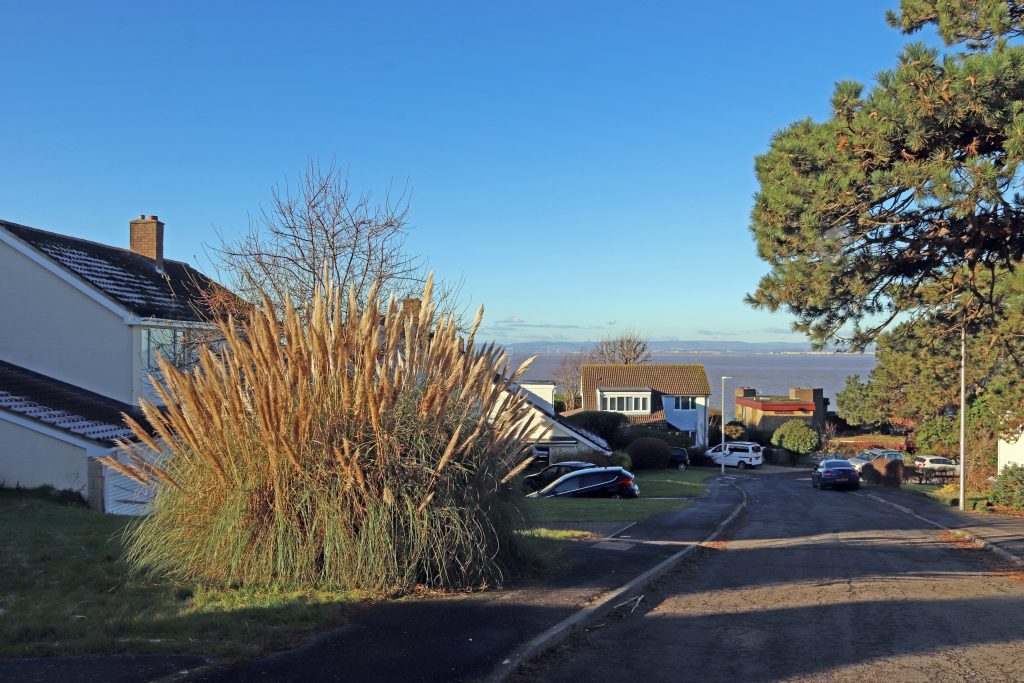
Residential area west of Sugar Loaf beach

The impressive clock tower at Fedden Village, the former National Nautical School
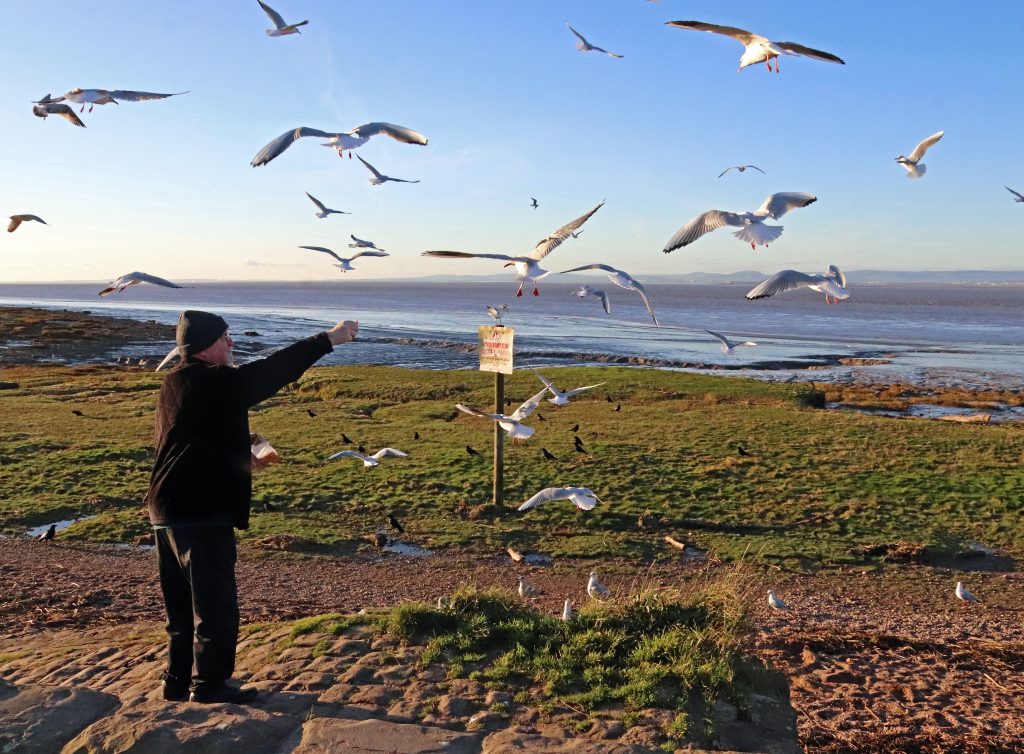
Feeding birds with the remains of a festive gammon at Woodhill Bay
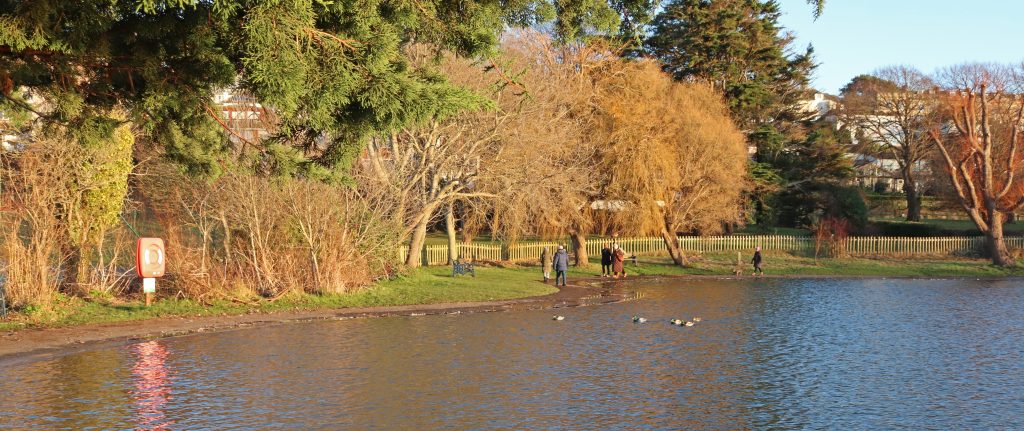
Edging the slightly flooded pathway around the Marine Lake at Portishead
As my husband commented as we passed the nearby Portishead Lido, ‘there’s a building that wants to be seen.’ Painted in bright yellow ochre and orange, this lido is quite a landmark but clearly a local treasure and inspiration for typographic prints and other artwork. Given it was the Christmas vacation only the lido’s café was bustling with activity on our visit and the pool itself was closed. However, a sneak peek at the Portishead Open Air Pool website afterwards indicates you can go for a cold water swim here at the weekend even in winter! It also informs you that the 33 m pool currently attracts over 50,000 visitors each year – quite impressive, but nowhere near the 250,000 visitors which were counted during its first two years of operation. Then, its unusually pleasantly warm waters were a key attraction – these, it seems had been heated by hot water, a by-product from a local phosphorus plant which was transported to the site by four to five tankers each day! Councillor Gunnell informs me that solar heating has recently been installed. A summer visit now seems likely …
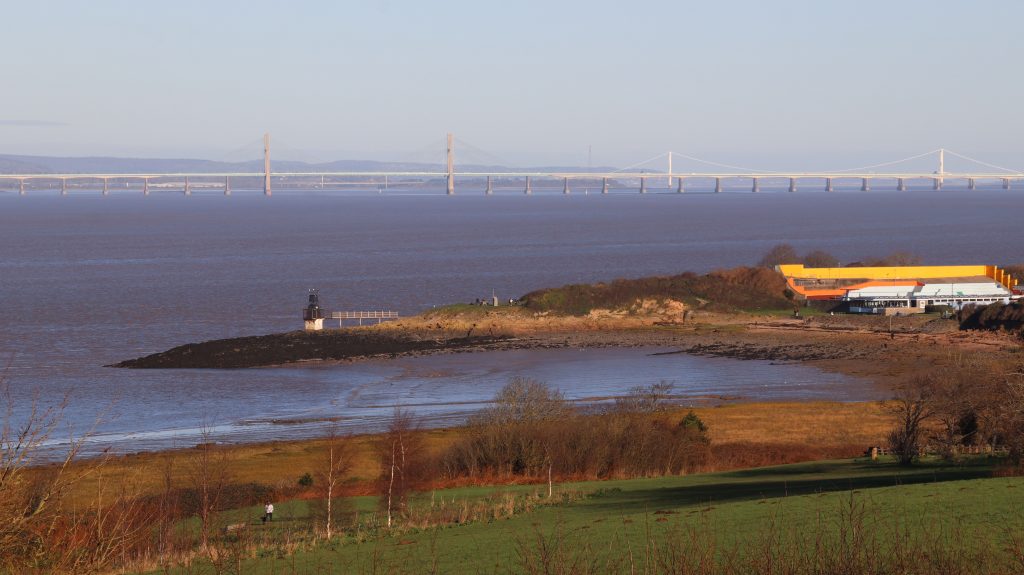
Looking towards Battery Point the lido is clearly visible from a distance!
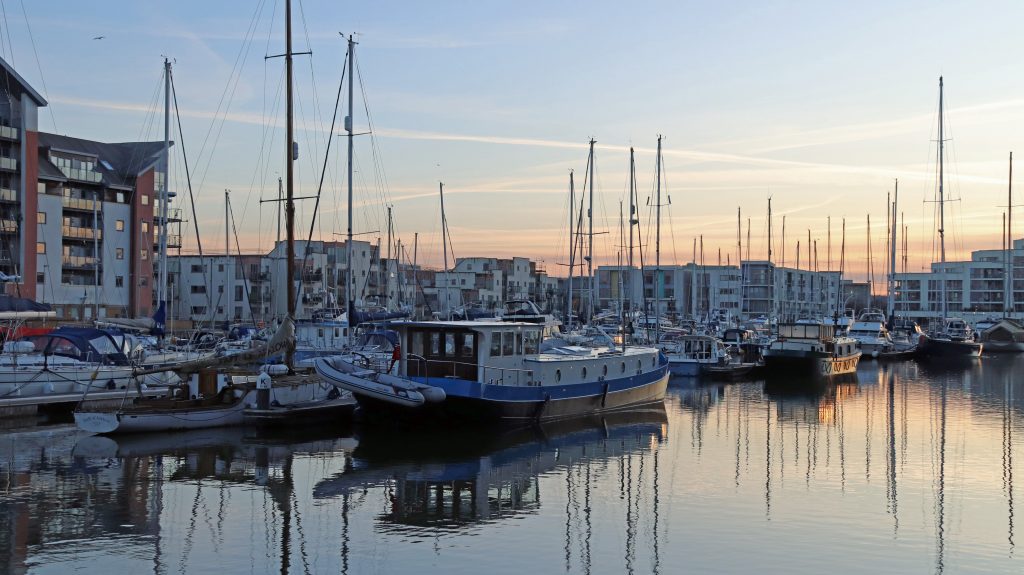
The early evening charm of Portishead Marina
Portishead Marina: now and then
As the sun was dipping below Battery Point and the temperatures began to plummet, we scurried back to the car and headed over to Portishead Marina for the last mini excursion of the day. A delightful recent dockland development awaited us – a great place for us to both to warm up and chill out, but only after quite a lengthy walk along the quayside to one of the few cafes still serving teas and coffees. In the now evening light, the design of the classy and coherently designed apartment blocks surrounding the dock could have fooled us to think we were somewhere abroad, not quite Amsterdam, but certainly continental. With some expensive-looking boats and yachts tastefully festooned with twinkling Christmas lights, the whole area exuded both a sense of calm and affluence. Such a stark contrast to the dock’s industrial years when not one but two power stations had belched filthy smoke into the air for a while until the early 90s when they were demolished.
If you’ve read my previous article about Gloucester docks, there’s been a similar pattern of industrial growth and post-industrial decline here before a more recent redevelopment phase. The latter included the opening of the marina in 2001, now one of the best equipped marinas in the south west and recipient of a coveted 5 Gold Anchor award from the Yacht Harbour Association. However, unlike Gloucester, little of the old industrial and maritime heritage remains here. You do still get a sense of the huge scale and depth of the dock here though – indeed, the dock had been built in 1860 to accommodate large ships which weren’t able to navigate the Channel further upstream. As we walked over the foot bridge my husband commented that it was quite ‘shocking to see the difference in level of the marina basin compared to the height of the estuary waters in the Severn’ – well, it was not that long after low water on a Spring Tide!
Final thoughts
Unfortunately, there was no time, light or tide at the end of the day for us to see any shipping activity offshore or indeed to visit the Portbury Nature Reserve, favourite activities of our two councillors. Hopefully, another time soon.
As with some of my previous visits along the Severn, what I’d initially thought of as a slightly non-descript coast, my short introductory visit had shown me that it was nothing like. There’s a wealth of historical interest and some lovely stretches of natural shoreline offering spectacular views across the Channel. So, whether you’re a history buff, nature lover, or simply in search of a scenic walk, the stretch from Redcliffe Bay to Portishead Marina offers a memorable experience which I’d encourage you to explore. However, what I’ve been most pleased to see on this and previous walks is the extent to which residents treasure their stretch of coast and have such passion for maintaining the beauty, amenity and environment of their patch. I’m very grateful to Councillors Eastman and Gunnell for sharing their views. Tapping into local community’s concerns has been so interesting and has made me much more aware of the delicate balance between nature and society at the local, as well as the estuary scale.
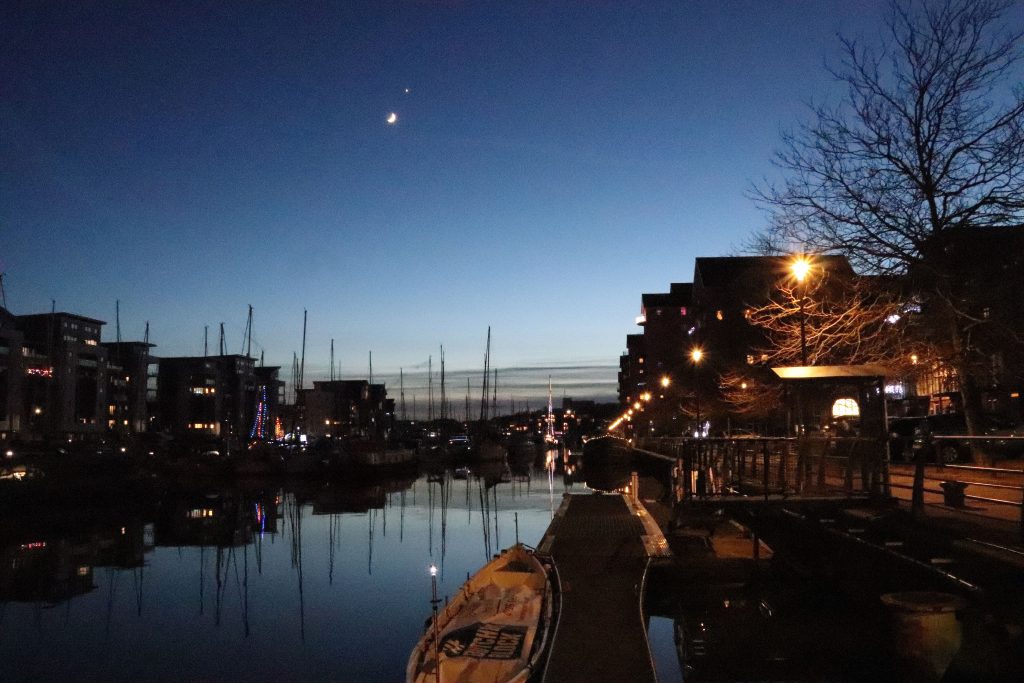
The magic of the marina under a clear night sky
A couple more interesting websites on the coast around Portishead
 Severn Estuary Partnership
Severn Estuary Partnership